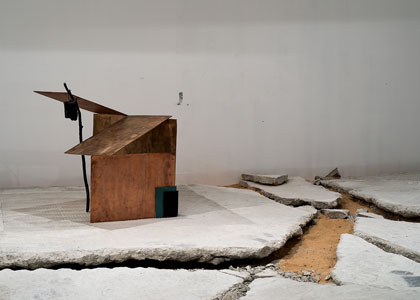Tatiana Trouvé, The Great Atlas of Disorientation
Curator: Hadas Maor
07/06/2018 -
29/09/2018

![]()

The first notions that come to mind when thinking of Tatiana Trouvé’s oeuvre are extreme delicacy, restrained violence, and an irreconcilable, overwhelming sense of transience. In her work, Trouvé explores the relations between time and space by constructing enigmatic environments founded on logical, architectural, and material distortions. These settings are manifested in large-scale drawings as well as large-scale, site-specific installations. The constant vacillation between the drawings and the sculptural and architectural installations elicits a sense of trickling from one medium to another; a feeling that one action is reflected in another, and that ostensibly disparate worlds are whirled together. The various spaces created in the works contain the concept of time in diverse ways—spatially, semiotically, and poetically, as if attempting to map that which has vanished and no longer exists, perhaps even oblivion itself. They are tantamount to receptacles of memory, whereby Trouvé seeks a momentary grasp of the ephemeral, which is immanent to the passage of time. The presence of the body is clearly discernible in her works, even though the body itself is never seen in the space.
Trouvé’s exhibition at Petach Tikva Museum of Art is comprised of two large-scale installations, each site-specific in its own way. Upon entering the first space, the viewer encounters a cracked, broken ground on which several sculptural objects are scattered: fragile-looking, temporary shelters of sorts, cast in bronze, aluminum, and copper from used sheets of cardboard which carry their chronicles in their creases, fractures, and scarred surfaces. Different objects are affixed to the sides of these structures: diaries, books, and additional material elements, also cast from the same substances as the structures. Some of these surfaces bear the imprint of Trouvé’s actions in the form of maps and signs, which refer to a wide range of periods and cultures. Thus, for instance, in Somewhere in the Solar System (2017), the roof of the structure is imprinted with a 1704 map drawn by 17th-century adventurer Giovanni Francesco Gemelli Careri. The map charts the imaginary migration trajectory of the Maja in the direction of Mexico City, and contemporary migration routes are delineated on it with long curved arrows. The difference in the route marking also reflects the ideological gap regarding the concept itself: from a coveted process of discovering the world to a gloomy result of a political state of affairs which transforms ordinary citizens into homeless, stateless refugees who have no status in the world.
Another work, whose title is identical to that of the exhibition, The Great Atlas of Disorientation (2017), features a celestial navigation map, a geological timeline, a phylogenetic evolution chart, a timeline for the end of the world, a mandala drawn by Carl Jung, and more. Other works present the tracks of a 1973 NASA mission, maps of the solar system, and so on—an intellectually- and culturally-broad array that assumes a material dimension.
The works oscillate between history and fiction, between a general stance and a particular stance, between being conceptual representations of knowledge and of ways in which to organize and represent knowledge, and being carriers of narrative. Structurally speaking, the objects are basic, minimalist constructions, which offer only partial shelter. They are not entirely closed off from the outside, therefore they do not produce an actual interior, but rather interwoven exteriors and interiors that invade one another. In this sense, they offer a series of new perspectives on the world—partial, changing perspectives that swirl and emerge from one another, presenting a fundamental contrast to the all embracing gaze offered by the structure of the panopticon, for instance. As aforesaid, the objects are interspersed in a space set on a cracked, broken ground, possibly due to the passage of time, or to some apocalyptic event. In some sections on the ground, the marks of blankets, cardboard sheets, and various objects are imprinted, as if they had been assimilated or buried in it. This element imbues the space with a degree of disquiet, a sense of implicit danger, that arises both from one’s awareness of the geological movement of the earth, and from the caution that the viewer is required to exercise while moving through this post-apocalyptic sphere. The viewer’s body thus reacts directly to the works, and is denied the neutral position of spectatorship that is historically associated with the concept of the white cube.
The space carries the tension between soft and rigid, permanent and short-lived, catastrophe and utopia, as well as between past, present, and future. Above all, it raises questions concerning perspective, time, and memory. The suggestion embodied in it is conceptual, meditative, and inevitably also political, since the exhibition explores the concept of home and raises acute questions concerning displacement, migration, and the quest for a broader cultural context and meaning.
The titles of the works attest to a persistent, ongoing search for possibilities and alternatives involving multiplicity and concurrence. Thus, for example, History Map of the Interworld (2017) unfolds a state of expansion and transgression. It produces an additional, ex-territorial sphere, at once present and absent. The Great Atlas of Disorientation introduces a system for cartographic mapping of that which cannot be mapped or regulated. Thus, the tension between knowing and not-knowing, between existent and potential, runs through the works, as it does through Trouvé’s overarching artistic practice.
In many of Trouvé’s exhibitions, an object titled The Guardian is situated at the entrance to the space: a cast chair into which a long copper pole is assimilated, as if sunken into the seat cushion—replacing the human presence that is supposed to occupy it, and effectively impeding the functional use of the chair. Other frequently recurring objects are associated with the human body—mattress, pillow, blanket—objects which are supposed to provide it with support or protection, yet are all isolated, detached from the body, and fossilized. In the current exhibition The Guardian is not present, and the space appears as an abandoned, emptied non-place in which there remains nothing to guard. The present-absent dimension of this lacking work, as well as of the makeshift structures scattered throughout the space, conjure up the notion of the uncanny (unheimlich), whose very essence involves a repeated concern with borders and boundaries, and especially with deviation from them.
The entrance to the first exhibition space is akin to entering one of Trouvé’s large-scale drawings—works featuring a vast open space in which smaller, circumscribed spaces are both demarcated and invaded; since the spaces in Trouvé’s drawings always offer multiple possibilities and fluid movement among different worlds. The transition to the interior space, where the work Prepared Space (2018) is presented, amplifies the sense of immersion within a work of art, since the act of drawing already identified in the transient structures, such as The Great Atlas of Disorientation, seems to have expanded in the space, covered the entire floor, climbed the walls, totally enveloping the viewer situated within it. The entirely white space is marked by trajectories, long slits into which spacers, borrowed from the world of architecture and construction, are inserted. The various trajectories intersect and come together to form an abstract navigation map with several vanishing points, which is a mathematical drawing that always includes a fixed number of trajectories. The spacers inserted in the work usually serve to fix supporting beams prior to the casting of concrete, and are assimilated into the casting as it is made. Here, however, they are stripped of their function and remain exposed to the gaze, punctuating the space, as it were.
Whereas in 350 Points toward Infinity (2009), Trouvé uses a pendulum, activated by the earth’s magnetic field, which she repeatedly diverted to create an alternate field of tension, in this work she employs a simple, widely available tool, which she transforms and converts by casting it in bronze, while simultaneously detaching it from its functional context. These small elements thus shift elusively between the readymade and the unique, the found and the manufactured, the functional and the conceptual, as they are transformed from a latent element in the construction process to a significant component, which carries and organizes the entire work.
Located almost offhandedly in one corner of the space, Refolding (2013) is a bronze and concrete cast of a pile of folded emergency blankets and cardboard boxes, ready to be disposed of after use. Designated for wrapping and containing, both the blankets and the boxes are transformed in this work into rigid, condensed surfaces that fold in upon themselves, acquiring a different formalist meaning. Surprisingly, however, they are still imbued with an awareness of the softness they carry and the tactility they represent.
In his book The Road (2006), Cormac McCarthy repeatedly describes the few blankets left to the father and son, nameless characters making their way toward the sea and leading the plot, in the timelessness following the end of the world. At the conclusion of the book, upon the father’s death, one of the blankets serves as a decisive narrative means for creating a new horizon of hope. In the exhibition space, too, the blankets offer a form of solace; a possibility, or chance, of active human presence, albeit a misleading, deceptive one.
Daniel Milman Tatiana Trouvé

